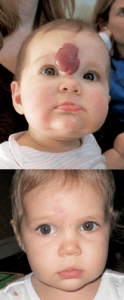Port wine stains are harmless, congenital vascular anomalies affecting about three out of every 1000 newborns.
Also referred to as a birthmark, port wine stains differ slightly from less florid skin discolorations because they are deep red or purplish in color and resemble severely inflamed patches of skin. Vascular anomalies producing a port wine stain are the result of capillaries that failed to form properly during gestation, a condition that is predominantly hereditary. On rare occasions, port wine stains comprise symptoms of syndromes, specifically the Klippel-Trenaunay-Weber syndrome or the Sturge-Weber syndrome.
What Causes Port Wine Stains?
When an area of a child’s skin fails to receive enough nerve fibers during gestation, blood vessels cannot develop normally and expand instead. This allows too much blood to enter capillaries, which continue to expand to accommodate greater amounts of blood. Eventually, a purplish-red port wine stain develops as a result of these engorged capillaries. This excess blood is why PWSs are so much darker than other areas of skin containing normal amounts of nerve fibers and blood flow.
Facts about Port Wine Stains
Research indicates that aggressively treating port wine stains as soon as possible facilitates eradication of PWS when it is eventually treated. Children possess lesser amounts of epidermal melanin than adults, which promotes the ability of laser therapy to eliminate port wine stains. Because melanin tends to absorb laser light energy, adults with port wine stains and extra melanin naturally inhibit the efficacy of laser therapy needed to evaporate damaged capillaries. Moreover, young children also have less skin collagen, a substance that also restricts the ability of laser light to spread throughout the port wine stain.
What is the Difference Between a Port Wine Stain and a Birthmark?
A port wine stain is actually a type of birthmark. However, most other types of birthmarks may not require treatment because they usually fade over time. Common birthmarks that do not involve capillary malformation found in PWSs include:
- Salmon Patch—also called an”angel kiss” or “stork bite”, the salmon patch birthmark is seen on nearly half of all babies born. Usually appearing on the forehead, back of the head neck or eyelids, a salmon patch is pinkish, irregularly shaped and harmless. Most fade by the time the child is five years old and do not need removed.
- Strawberry Hemangioma—this birthmark is rarer than port wine stains, occurring in about one out of every 400,000 births each year. Although a strawberry hemangioma may not be present at birth, it will emerge shortly after birth as a raised, red patch of skin resembling a strawberry in color and size. Although these vascular birthmarks enlarge rapidly during a baby’s first year, they are harmless and eventually disappear in about 70 percent of children affected by them. However, if a strawberry hemangioma is located in a visible area—the face or neck, for example—it may need removed to prevent self-esteem issues from affecting the child if it does not fade in time.
Congenital Moles
Moles that are present on the skin at birth are considered birthmarks, or congenital nevii. Congenital moles are permanent, black, tan or brown in color and can be any shape or size. Sometimes they appear as a singular mole while other instances of congenital moles are clustered and consist of multiple moles dotting a small area of the body. This type of birthmark requires no treatment during childhood or adolescence but may need monitored in adults who have a family history of skin cancer.
Mongolian Spots
Found in darker-skinned babies, Mongolian spots resemble a flat, bluish-gray bruise and mostly appear on the buttocks or lower back. Fading by the time the child is four or five years old, Mongolian spots are harmless and do not need treatment.
Remove Port Wine Stains and Other Birthmarks in Children and Adolescents
Mayoral Dermatology recommends removing port wine stains or other noticeable birthmarks before a child enters school so that the child does not have to feel different, experience teasing by other children or suffer from self-esteem issues. Appearance is important to school-age children and having a “normal” appearance contributes greatly to their self-confidence and ability to interact socially later in life. If you or your child has a port wine stain or birthmark that is causing embarrassment, contact Mayoral Dermatology to schedule a consultation with one of our professional, caring specialists experienced in treating younger patients.


